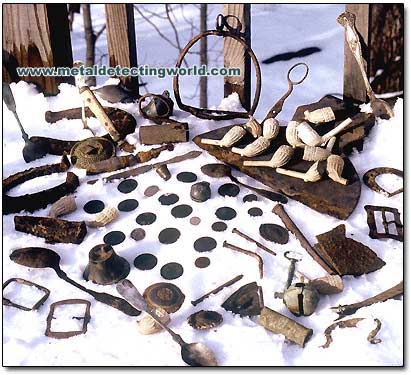Photo Galleries of Relics and Artifacts Found with a Metal Detector in the US and Abroad
Searching for Relics and Artifacts Can Bring You as Much Excitement as Metal Detecting Coins
The following photo galleries show finds that represent a wide variety of relics which I metal detected at different locations both in the US and abroad before 2008, and WWII artifacts discovered by military relic hunters in Europe.
In Brief:
by Sergei UpstateNY, last time modified:

In the US, I have relic hunted primarily in the North-East, the oldest historical area in America, which saw all major events of the French-Indian War, Revolutionary War and War of 1812. A wide variety of Colonial and military relics truly makes Relic Hunting in the North-East USA both enjoyable and educational.
While metal detecting along with treasure hunters in Eastern Europe, I saw them throwing some interesting and valuable relics away because such items had not been commonly considered valuable, and most detectorists simply could not identify them. Amazingly, the relic finds of the 18th and 19th centuries in Europe and America are identical. With my knowledge of American Colonial artefacts, I was glad to help my European friends in identifying their relic finds so at least a few valuable items could be salvaged.
Before I attained the knowledge on relics, their types and origins, I used to discard most of my relic finds the same way my European treasure hunting buddies did.
Later I wished I attained the knowledge of relics and artifacts before I started metal detecting. It is important to know what you find, and preserve invaluable pieces of history.
I recommend the following two books on the American relics to those who are interested in relic hunting or artifact collecting:
- 1) "Collector's Illustrated Encyclopedia of The American Revolution" by George C. Neumann and Frank J. Kravic.
- 2) "A Guide To Artifacts of Colonial America" by Ivor Noel Hume.
Both books are very helpful in authentication and identification of relic finds.
After traveling and metal detecting in a few areas of the former Soviet Union, I have noticed that relic hunting for WWII military artifacts, mostly conducted by methods that exclude use of traditional metal detectors, is on a much larger scale than relic hunting for non-military artifacts, ca. 14th-19th century. Such an indifferent attitude towards the non-military artifacts could be explained by (1) lack of the literature for reference that could help in identification of such relic finds, (2) the market for this type of artifacts being overflooded with items that can be obtained in rural areas for cheap prices, (3) higher collectors' demand for coins than relics, etc.